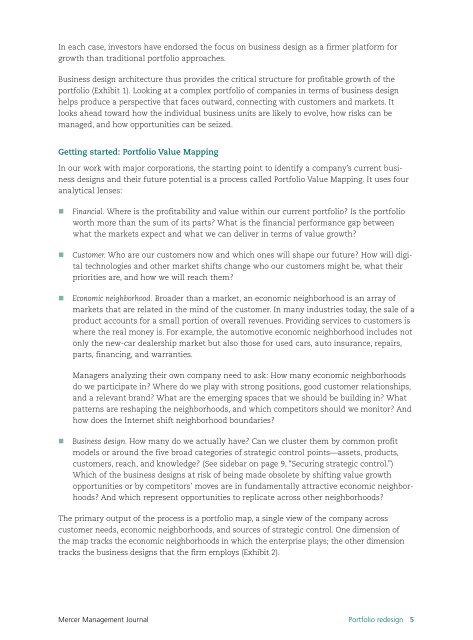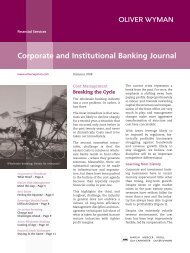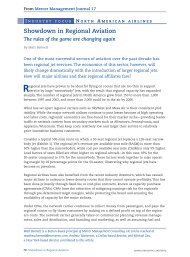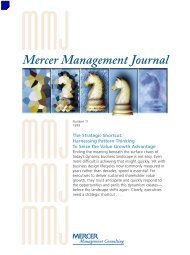Download the Report - Oliver Wyman
Download the Report - Oliver Wyman
Download the Report - Oliver Wyman
You also want an ePaper? Increase the reach of your titles
YUMPU automatically turns print PDFs into web optimized ePapers that Google loves.
In each case, investors have endorsed <strong>the</strong> focus on business design as a firmer platform for<br />
growth than traditional portfolio approaches.<br />
Business design architecture thus provides <strong>the</strong> critical structure for profitable growth of <strong>the</strong><br />
portfolio (Exhibit 1). Looking at a complex portfolio of companies in terms of business design<br />
helps produce a perspective that faces outward, connecting with customers and markets. It<br />
looks ahead toward how <strong>the</strong> individual business units are likely to evolve, how risks can be<br />
managed, and how opportunities can be seized.<br />
Getting started: Portfolio Value Mapping<br />
In our work with major corporations, <strong>the</strong> starting point to identify a company’s current business<br />
designs and <strong>the</strong>ir future potential is a process called Portfolio Value Mapping. It uses four<br />
analytical lenses:<br />
TFinancial. Where is <strong>the</strong> profitability and value within our current portfolio? Is <strong>the</strong> portfolio<br />
worth more than <strong>the</strong> sum of its parts? What is <strong>the</strong> financial performance gap between<br />
what <strong>the</strong> markets expect and what we can deliver in terms of value growth?<br />
TCustomer. Who are our customers now and which ones will shape our future? How will digital<br />
technologies and o<strong>the</strong>r market shifts change who our customers might be, what <strong>the</strong>ir<br />
priorities are, and how we will reach <strong>the</strong>m?<br />
TEconomic neighborhood. Broader than a market, an economic neighborhood is an array of<br />
markets that are related in <strong>the</strong> mind of <strong>the</strong> customer. In many industries today, <strong>the</strong> sale of a<br />
product accounts for a small portion of overall revenues. Providing services to customers is<br />
where <strong>the</strong> real money is. For example, <strong>the</strong> automotive economic neighborhood includes not<br />
only <strong>the</strong> new-car dealership market but also those for used cars, auto insurance, repairs,<br />
parts, financing, and warranties.<br />
Managers analyzing <strong>the</strong>ir own company need to ask: How many economic neighborhoods<br />
do we participate in? Where do we play with strong positions, good customer relationships,<br />
and a relevant brand? What are <strong>the</strong> emerging spaces that we should be building in? What<br />
patterns are reshaping <strong>the</strong> neighborhoods, and which competitors should we monitor? And<br />
how does <strong>the</strong> Internet shift neighborhood boundaries?<br />
TBusiness design. How many do we actually have? Can we cluster <strong>the</strong>m by common profit<br />
models or around <strong>the</strong> five broad categories of strategic control points—assets, products,<br />
customers, reach, and knowledge? (See sidebar on page 9, “Securing strategic control.”)<br />
Which of <strong>the</strong> business designs at risk of being made obsolete by shifting value growth<br />
opportunities or by competitors’ moves are in fundamentally attractive economic neighborhoods?<br />
And which represent opportunities to replicate across o<strong>the</strong>r neighborhoods?<br />
The primary output of <strong>the</strong> process is a portfolio map, a single view of <strong>the</strong> company across<br />
customer needs, economic neighborhoods, and sources of strategic control. One dimension of<br />
<strong>the</strong> map tracks <strong>the</strong> economic neighborhoods in which <strong>the</strong> enterprise plays; <strong>the</strong> o<strong>the</strong>r dimension<br />
tracks <strong>the</strong> business designs that <strong>the</strong> firm employs (Exhibit 2).<br />
Mercer Management Journal Portfolio redesign 5
















